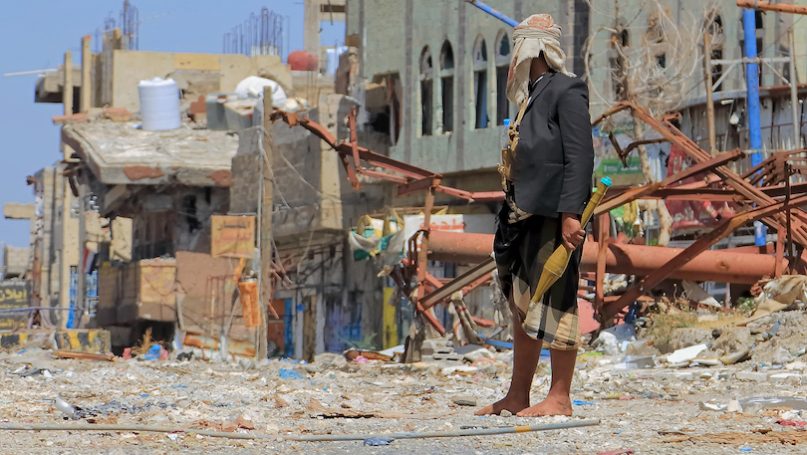
The conflict in Yemen has climbed up the escalation ladder with a Houthi attack on UAE’s critical infrastructure on January 17th. Three fuel tanks near the Abu Dhabi National Oil Company were blown up as a consequence of a drone attack launched by the Houthi militia. The attack also instigated a small-scale fire at Abu Dhabi airport. While Saudi Arabia had previously been a target for such missile and drone attacks by the Houthis, this is the first attack at this level on UAE territory. The Iran-backed rebels had already attracted the wrath of Abu Dhabi as it rejected the call by the United Nations to release the UAE-flagged ship that it had seized in early January. As the fight heats up in Yemen, this attack on vital facilities in UAE could be seen as an immediate retaliation to the Arab coalition’s airstrike that killed 280 Houthi fighters only a day before.
The trajectory of the conflict seems to be stuck in a vicious cycle involving attacks and counter-attacks. This leaves little prospects for a peaceful resolution as it gradually blurs the distinction of being a civil war and a sub-conventional conflict – overflowing into Saudi Arabia and UAE. With its material and training support, Iran has been pushing forward its agenda of expanding its sphere of influence in an attempt to challenge Arab influence in the region.
The recent sequence of events could act as a catalyst to bring Riyadh and Abu Dhabi closer to aid the coalition’s resistance against the Houthis by overlooking some major divergences that have tested their cohesion in the past. The UAE’s main focus was on the southern part of Yemen that houses Aden – a seaport hosting significant maritime commerce. Whereas, Saudi Arabia’s concerns centred around the Houthi’s hold of northern Yemen that is in proximity to the Kingdom’s territory. With the attack on UAE bringing out realisations to the Emiratis of the possibility of the state’s territory becoming a target for the Houthis, the coalition is likely to see a revitalised role with both the Arab regional powers being keen on uprooting the Houthi clout in Yemen before concentrating on other strategic interests.
It was only recently Yemen’s internationally recognised government forces reclaimed the southern province of Shabwa. This was considered as a significant move, but the response in the form of an attack by Houthis on the UAE has cast into doubt whether there is any possibility of peace. Perhaps the announcement of ‘liberation of Shabwa’ had provoked the Houthi reaction. Vacating Shabwa, the rebels seem to have moved to Bayda and Marib only to plan a retaliation. The Houthis are also seeking to get back their supply chain, which is being disrupted by the ongoing fight for the key city of Marib. The attack could also be seen as a diversion tactic to ensure that the forces move in large numbers to protect critical areas, which can give the go-ahead to the Houthis for their pursuit to regain lost territories.
The Houthis are not currently attacking UAE’s infrastructure as they did earlier this year, for example when seized an Emirati ship in the Red Sea off Hodeida. Despite lingering speculation, conflict escalation was contained. Now there seems to be a well-founded fear that UAE and Saudi Arabia may intensify the conflict even if it is at the cost of disrupting the likelihood of a peaceful resolution. Not responding strongly and decisively would be a loss of face for UAE and Saudi Arabia considering the Iran angle.
Three important scenarios emerge during this crisis. Firstly, Saudi Arabia and UAE would perhaps pressurise the world leaders and major powers to condemn the attack and follow it up with more sanctions towards Iran and call out Iran as a habitual sponsor of terrorism.
Secondly, the pressure to impose sanctions or other coercive measures would invariably bring the US into the crisis. As of now, the Biden administration has ceased its material support in the form of weapons to Saudi Arabia for fighting the Houthis in Yemen. US reaction to has been restricted to condemning and emphasising ‘unwavering commitment to the security of UAE and standing united with (our) Emirati partner’. What more the two Arab powers can expect from the US, especially considering the effect on the Vienna nuclear talks with Iran, is yet to be seen.
Thirdly, the Iranian regime is hinting at and targeting the clamour around the Abraham Accords by using its proxies. Tehran would want to target the strategic triangle between Abu Dhabi, Tel Aviv and Riyadh (even though it hasn’t signed the Accords) to resist it from becoming a trigger for other states which are yet to normalise their relations with Israel. The UAE also has, so far, been cautious not to point fingers at Iran. This event could, nonetheless, disturb UAE’s efforts to foster healthy economic ties with Iran to quell the harm posed by the Yemeni conflict to the region.
At a juncture when a crucial development in the slated dialogue between the Arab Gulf states and Iran was highly anticipated, the recent attacks will force Saudi Arabia and UAE to reconsider such a move. While a step was kept forward to move towards considering an engagement with Iran, this escalation could cause Riyadh and Abu Dhabi to pull back, further endangering stability in the region.
The repercussions of these events do not sting these regional rivals as much as they hit hard on war-torn Yemen. The scenario in Yemen in the midst of recent violence only draws more attention to the layers of complexity that have to be unfolded in order to resolve the conflict.